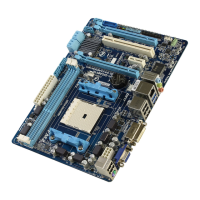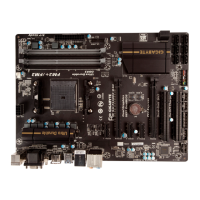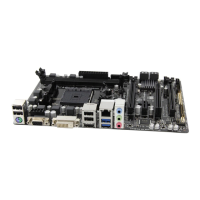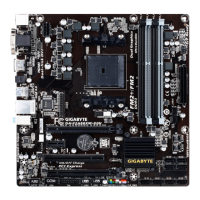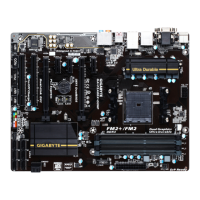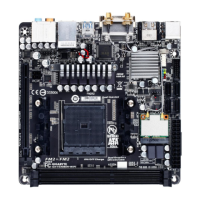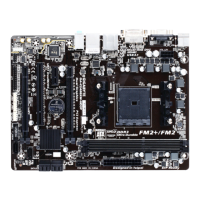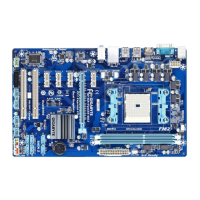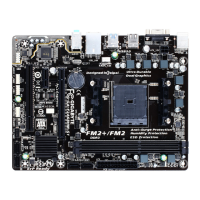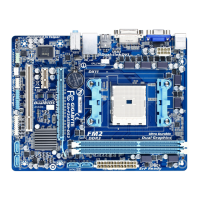
Do you have a question about the Gigabyte GA-F2A85X-UP4 and is the answer not in the manual?
| Memory voltage | 1.5 V |
|---|---|
| Memory channels | Dual-channel |
| Memory slots type | DIMM |
| Number of memory slots | 4 |
| Supported memory types | DDR3-SDRAM |
| Maximum internal memory | 64 GB |
| Supported memory clock speeds | 1066, 1333, 1600, 1866 MHz |
| Processor socket | - |
| Processor manufacturer | AMD |
| Compatible processor series | AMD Athlon |
| Power fan connector | Yes |
| Number of SATA III connectors | 7 |
| USB 3.2 Gen 1 (3.1 Gen 1) connectors | 1 |
| USB 2.0 ports quantity | 2 |
| Firewire (IEEE 1394) ports | 0 |
| Audio chip | Realtek ALC892 |
| Component for | PC |
| Motherboard chipset | AMD A85X |
| Audio output channels | 7.1 channels |
| Motherboard form factor | ATX |
| Supported storage drive interfaces | SATA III |
| PCI Express x1 slots | 3 |
| Ethernet interface type | Gigabit Ethernet |
| BIOS type | AMI |
| Depth | 244 mm |
|---|---|
| Width | 305 mm |
Details compliance with EMC Directive requirements.
Details compliance with LVD Directive requirements.
Details compliance with RoHS Directive requirements.
Statement of compliance with FCC Part 15, Class B Digital Device.
Explains types of documentation provided by GIGABYTE.
Guide on how to find the motherboard's revision number.
Lists the items included in the motherboard package.
Lists optional accessories available for purchase.
Visual guide to identify key components and connectors on the motherboard.
Illustrates the functional blocks and data flow of the motherboard.
Essential safety guidelines and precautions before installing hardware.
Details specifications for APU socket and Chipset.
Information on supported DDR3 memory modules and Dual Channel Technology.
Specifications for onboard graphics ports and audio codec.
Details available PCI Express slots and multi-graphics support.
Details SATA and eSATA connectors and RAID support.
Information on USB 3.0/2.0 and USB 2.0/1.1 ports.
Lists various internal headers and external connectors on the motherboard.
Details I/O controller chip, hardware monitoring, and BIOS features.
Lists bundled software and supported operating systems.
Specifies the motherboard's physical dimensions.
Important guidelines before installing the APU.
Instructions to identify APU markings and insert APU into socket.
Important guidelines before installing memory modules.
Explains how to configure memory for dual-channel performance.
Precautions and steps for installing expansion cards like graphics cards.
Lists requirements for setting up AMD Dual Graphics.
Instructions for configuring BIOS and graphics card drivers for Dual Graphics.
Lists requirements for setting up AMD CrossFire.
Steps to connect graphics cards and configure drivers for CrossFire.
Details PS/2, USB, D-Sub, DVI-D, and HDMI ports.
Describes DisplayPort, USB 2.0/1.1, and eSATA ports.
Explains RJ-45 LAN port LEDs and various audio jack functionalities.
Overview of ATX power connectors.
Details fan headers, battery, SATA connectors, and Clear CMOS jumper.
Describes front panel, audio, and S/PDIF Out headers.
Detailed pinout information for ATX 12V and ATX main power connectors.
Details fan headers and the CMOS battery.
Details SATA connectors and the Clear CMOS jumper.
Explains how to connect chassis front panel components like power/reset switches and LEDs.
Details connection for HD Audio, AC'97 audio, and S/PDIF Out.
Details the USB 3.0/2.0 header and its pinout.
Details the USB 2.0/1.1 headers and their pinouts.
Details the COM header and the TPM header.
Explains the function of the power, reset, and clear CMOS buttons.
How to enter BIOS Setup and upgrade BIOS using Q-Flash or @BIOS.
Describes the GIGABYTE logo screen that appears during boot.
Lists and explains the function keys used in BIOS Setup and utilities.
Overview of the 3D BIOS graphical interface.
Overview of the main menu structure and navigation.
Detailed list of function keys for BIOS navigation.
Overview of the main BIOS setup menus (M.I.T., System, BIOS Features, etc.).
Displays current status and options for CPU/memory frequencies.
Controls for BCLK, PCIe clock, CPU graphics clock, and CPU frequency.
Settings for CPU core ratio, performance boost, and power saving features.
Settings related to memory performance enhancement and multiplier.
Configuration for DRAM timing, voltages, rank, and channel interleaving.
Detailed memory timing controls and voltage adjustment options.
Monitors system voltages, temperatures, fan speeds, and chassis intrusion.
Displays current system voltages, temperatures, and fan speeds.
Settings for CPU and system fan speed control modes.
Displays system information about the motherboard and installed OS.
Settings for BIOS language, system date, and time.
Configures boot order, passwords, and security options.
Controls compatibility for legacy BIOS, boot modes, and device boot priorities.
Settings for PCI ROM priority, network boot, and administrator/user passwords.
Settings for SATA channels, types (IDE, RAID, AHCI), and port configurations.
Controls onboard USB and HD Audio functions.
Settings for onboard LAN, USB controllers, and Trusted Platform Module.
Configures SATA hot plug and power settings for each port.
Settings for primary video device, integrated graphics, and UMA frame buffer size.
Settings for system wake-up by alarm and High Precision Event Timer.
Configures power saving in shutdown state and power button behavior.
Controls system state after AC power loss and keyboard/mouse wake-up.
Options to enable system power-on using keyboard or mouse.
Saves BIOS changes and exits the setup.
Loads default BIOS settings to restore optimal system operation.
Allows saving and loading BIOS settings profiles.
Guide for installing motherboard chipset drivers using the utility.
Installs bundled utilities and provides driver disk content descriptions.
Provides GIGABYTE contact details and basic system information.
Links to GIGABYTE website for updates and installs utilities.
Introduces GIGABYTE's Q-Flash and @BIOS utilities for updating the BIOS.
Step-by-step guide to update BIOS using the Q-Flash utility.
Recommends loading optimized defaults after a BIOS update.
Guide to update BIOS using the Windows-based @BIOS utility.
Explains EasyTune 6 for system fine-tuning, overclocking, and monitoring.
Describes Q-Share for easy data sharing over a network.
Utility for backing up and restoring system partitions or files.
Steps to recover the system using Smart Recovery 2 or Windows installation disk.
Tool for enabling system power savings using a Bluetooth cell phone.
Instructions for setting up SATA drives and RAID arrays.
Steps to configure SATA controller mode (IDE, RAID, AHCI) within BIOS Setup.
Guide to use the RAID BIOS utility for creating RAID arrays.
Detailed steps to manually create RAID arrays using the RAID BIOS utility.
Step-by-step process for creating a RAID 0 array.
Shows assigned drives and unassigned drives in the RAID utility.
Instructions on how to delete disk array assignments.
Guide for installing Windows 7/Vista with SATA RAID/AHCI drivers.
Steps to install Windows XP using a floppy disk with SATA RAID/AHCI drivers.
Details the driver installation process during Windows XP setup.
Process for rebuilding a RAID array using AMD RAIDXpert.
Guide to configure multi-channel audio jacks and speaker assignments.
Settings for sound effects and activating AC'97 front panel audio.
How to mute back panel audio when a front headphone is plugged in.
Steps for connecting and configuring S/PDIF Out for digital audio output.
Steps to connect and configure microphone input and adjust recording volume.
How to record sound and enable Stereo Mix.
How to record sound and play it back using the Sound Recorder.
Answers to common troubleshooting questions about the motherboard.
Flowchart to diagnose and solve system startup issues.
Continues the troubleshooting flowchart for common hardware problems.
Explains codes displayed by the debug LED during boot for diagnostics.
Continues the list of debug LED codes and their meanings.
Lists debug codes related to S3 resume, recovery, and error states.
Continues listing error-related debug codes.
Legal notices, copyright, and disclaimer regarding the manual's content.
Information on RoHS and WEEE directives and product recycling.
Lists contact details for GIGABYTE offices worldwide.
Information on accessing the GIGABYTE Global Service System for technical support.
